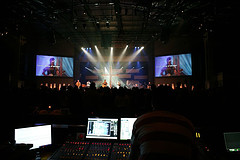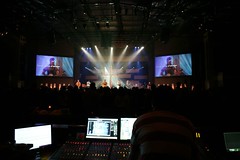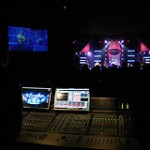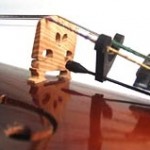
An Optimized Year…

When I started out this year, one of my goals was to vastly improve my system optimization skills. I spent a lot of time researching on methodology. I had conversations with various engineers. I flew across the country to learn directly from a pro. Then I spent a lot of hours playing and experimenting in my rooms. Now as the end of the year approaches I have to say I feel pretty confident in my ability to optimize a system.
One of the “benefits” I’ve discovered from having a couple of aged PA’s is that they require regular attention. Last week I retuned our PA in the east auditorium for what was probably the third time this year.
My first stab was during the week leading up to Easter. It was probably not the best time to do it, but I was pretty happy with the results, and the general consensus was that I had made the east auditorium sound like a new room. I wouldn’t go that far in describing the results, but it was a definite improvement. I attribute the results of that optimization more to the fact that I changed our three main clusters from a Left, Mono, Right configuration to a Left, Center, Right configuration. The optimization helped, but I think LCR is what opened things up. I could spend a lot of time discussing three-cluster point source PA configurations after the experimentation I’ve done over the last year, but I’ll just briefly explain why I changed things in this way: When the center cluster was a mono mix, all the energy was in the center of the room and stacking up in the center cluster. I think the result of this was that the FOH engineer was getting a skewed perspective of what was happening in the room since he was seated more center; it sounded great at FOH, but had a tendency to fall apart on the outsides of the room where the subs seemed to take over. When I flipped to LCR, the energy became even across the entire PA image. Now a couple quick things about my configuration while I’m on the LCR subject. The center channel in my setup is NOT a discrete center; this is something that is only possible using a console with a divergence control. When I pan something center in my room, it is even in energy in all the clusters. Mixing on this setup took a bit to get used to and some different ways of thinking about things, but that’s for another discussion. Back to optimization…
Later in the year we added a couple of sidefills to fill some holes on the sides of the room. We also upgraded our system processing to the modern age with a Meyer Galileo at the time. This seemed like a great time to once again address the tuning of our system since I essentially rewired the entire PA. Again, the results were satisfactory.
Last week I once again tackled the PA tuning. Why? It was out of whack…again. Our speakers are wearing out fast, and if I don’t keep an eye on things on a regular basis it just goes all over the place. Last week our Production Director commented to me that the clusters weren’t sounding consistent which was a sign that I had let it go too long. Thankfully, I didn’t need to worry about timing things in this time, and I just needed to check the room EQ. After a few hours of tweaking, I had things where I was happy. The thing that I am most satisfied about this time out is that I finally got the PA tuning to a place where I was comfortable taking a multiband comp off my master bus. When my predecessor had installed the Venue before my arrival, he had added a multiband comp to the master output to tame some of the harshness that I find innate in our current brand of loudspeakers. While it definitely helped for a long time, I was happy to finally get to a place where I could turn it off. Although, on Sunday there were definitely some spots I wished I still had it lightly in place, but I plan to leave it off for now.
After a year of focusing on PA tuning, I have to agree with Scovill that it’s very important for a mixer to understand how to tune a PA. I think the time I’ve spent focusing on this has actually helped my mixes and made me a better mixer as well. I think it just got me thinking about some things differently, and I was able to apply this holistically to mixing. It’s sort of hard for me to explain, but I’ll try at some point in the future when I start talking about imaging…
I’ll close this post with a couple of bits of wisdom I picked up this year from tuning my PA’s: #1.) Much like mixing, your tuning improves the more you do it. I tuned my east auditorium PA at least 3 times this year, and the west PA got just as much attention. Every time I tune, things get a little better. #2.) Don’t rely on measurements alone. I use SmaartLive when tuning and something that a lot of guys overlook is the coherence display. The coherence tells you how certain Smaart is of its measurements, and I’ve NEVER seen this to be perfect across the board so you HAVE to use your ears. #3.) If you have an aging PA that gets a workout, keep an eye on things periodically–make it part of your maintenance regimen to check your system tuning. Speakers are made of moving parts, and things don’t work the same over time.
That’s all for now. I’ll try and be back later this week if my Christmas prep doesn’t get too heavy.

 Previous Post
Previous Post Next Post
Next Post


